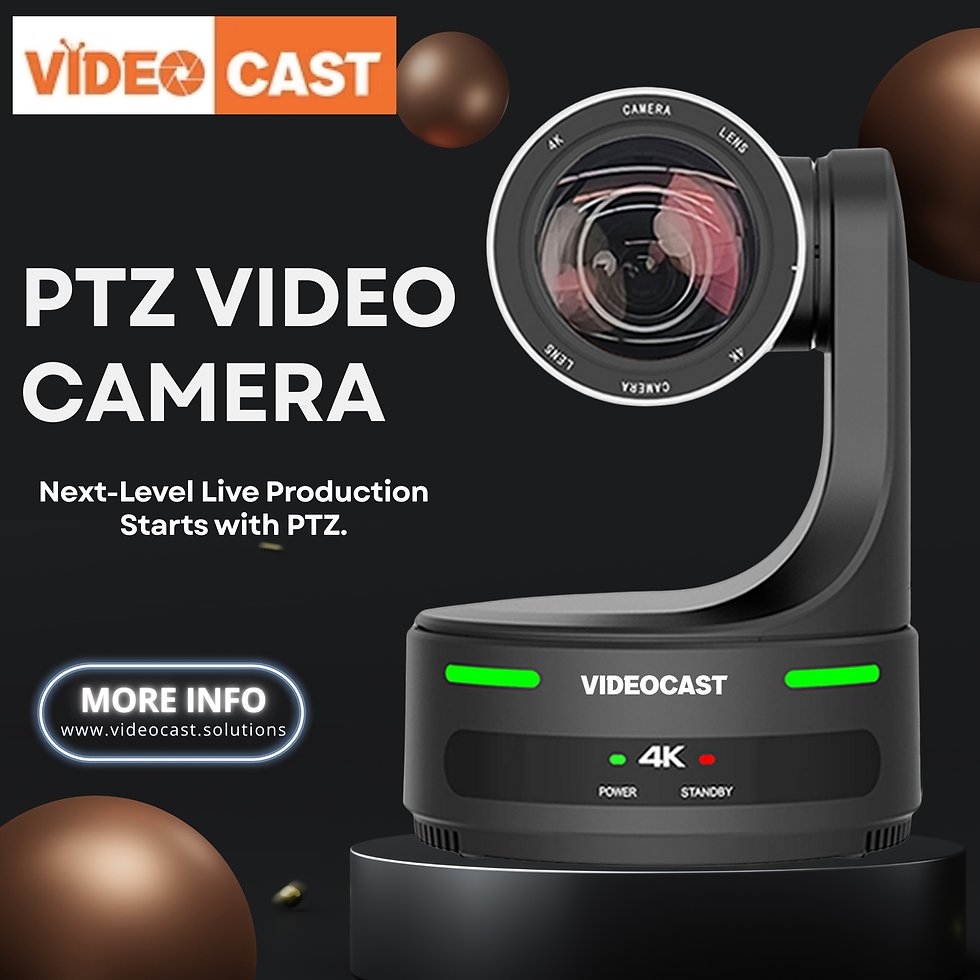Crystal-Clear Video Conferencing: Setup Tips That Work
- VIDEOCAST

- 6 days ago
- 4 min read
Updated: 23 hours ago
Video conferencing has become a core part of how today’s businesses communicate—whether it’s remote teams collaborating, virtual client meetings, or online training sessions. In the United States especially, where hybrid and remote work are now standard, having a reliable video conferencing setup isn’t just a convenience—it’s a necessity. A high-quality setup ensures that your message is delivered clearly, without distractions, technical hiccups, or poor video quality.

Understanding the Importance of Video Conferencing
Clear communication leads to better productivity, stronger relationships, and improved meeting outcomes. When video quality is clear and audio sounds natural, meetings feel more personal, more engaging, and more professional. A strong conferencing setup eliminates frustrations and ensures that every participant feels included, whether they are sitting in a boardroom in New York or working remotely from California.
Key Components of a High-Quality Video Conferencing Setup
A reliable video conferencing setup includes: Video
Camera or PTZ Video Camera
Microphone or Speakerphone
Display / Monitor
Video conferencing software
Stable internet connection
Lighting
Each component plays a vital role. Even a powerful laptop won’t help if the microphone picks up echo or your video Switcher is grainy.
Choosing the Right Hardware for Your Needs s
Hardware selection depends on the type of meeting space:
For professional outcomes, PTZ (Pan-Tilt-Zoom) cameras are becoming the standard in the US market. They provide crystal-clear video, smooth zoom, and motion tracking allowing speakers to move naturally.
Best Software Options for Seamless Video Conferencing
Top video conferencing platforms used in the US, UK, Europe, etc. include:
Zoom
Microsoft Teams
Google Meet
Cisco Webex
Most platforms integrate with PTZ Camera Controller and conference room systems. When choosing software, consider security, attendee capacity, and integration with your workflow (like scheduling with Google Calendar or Outlook).
Internet Connectivity: Ensuring a Stable Connection
For smooth video conferencing:
Minimum upload speed: 10 Mbps
Use wired Ethernet instead of Wi-Fi when possible
If using Wi-Fi, invest in a Wi-Fi 6 router for better stability
Bandwidth issues are the most common reason for lagging video or dropped calls.
Lighting and Background Considerations for Professionalism
Proper lighting dramatically improves video quality—even with a basic camera.
Tips:
Face a natural light source (window) whenever possible
Use a ring light or LED panel light
Keep background simple and clutter-free
Avoid strong back light behind you
Audio Quality: Tips for Clear Communication
Clear audio is more important than video. Choose one of these:
USB external microphone (best for individuals)
Table conference speakerphone (best for meeting rooms)
Ceiling microphone array (best for large rooms)
Turn off your laptop microphone—built-in mics pick up too much background noise.
Preparing for a Successful Video Conference
Before starting your meeting:
Test audio and video
Ensure proper camera framing
Close unused applications to improve performance
Share content or documents ahead of time
Troubleshooting Common Video Conferencing Issues
Conclusion: Elevating Your Communication Experience
A well-planned video conferencing setup transforms how you communicate. Whether you’re hosting client presentations or remote collaboration, the right camera, audio system, and lighting help you appear confident and professional. Investing in a quality setup ensures your meetings are productive, engaging and hassle-free. At Videocast Solutions, we offer a full range of Video Conferencing Setup such as PTZ cameras, controllers and video switchers designed for seamless remote production.
FAQs for Your Video Conferencing Blog
1. What equipment do I need for a professional video conferencing setup?
To achieve a professional setup, you’ll need:
A high-resolution webcam or PTZ camera
External microphone or conference speakerphone
Stable internet connection (preferably wired Ethernet)
Proper lighting (LED panel or ring light)
These components together improve video clarity and audio quality.
2. What is a PTZ camera and why is it better than a webcam?
A PTZ (Pan-Tilt-Zoom) camera allows you to:
Pan, tilt, and zoom smoothly
Autofocus and auto-track presenters
Cover larger rooms or multiple participants
Webcams are suitable for personal use, but PTZ cameras are ideal for meeting rooms, boardrooms, and training classrooms.
3. Does lighting really make a difference in video calls?
Yes. Even with a high-quality camera, poor lighting results in a dark or grainy image. Soft lighting from the front or side improves clarity and makes you appear more professional.
4. How fast should my internet be for video conferencing?
For smooth HD video calls:
Upload speed: Minimum 10 Mbps
Download speed: 25 Mbps or higher Wired Ethernet connections are more stable than Wi-Fi.
5. Why does my audio echo during meetings?
Echo happens when the microphone picks up sound from speakers.To fix this:
Use a conference speakerphone or external microphone
Lower speaker volume
Enable noise suppression in software (Zoom/Teams)
6. Should I use Zoom or Microsoft Teams?
Both are great options.
Zoom is user-friendly and ideal for webinars or client calls.
Microsoft Teams integrates well with Office 365 and internal corporate collaboration.
Choose based on your workflow.
7. How do I know which camera is suitable for my meeting room?
Here’s a quick guide:
8. Can I use wireless solutions for video conferencing?
Yes — wireless video transmitters and wireless USB connectivity allow:
Cable-free setup
Flexible camera placement
Clean and modern meeting rooms
Wireless systems are popular in US corporate environments.
9. How long does it take to set up a conference room?
With plug-and-play PTZ cameras and USB connectivity, a small room can be set up in 20–30 minutes. Larger rooms with audio DSP and ceiling mic systems take 1–2 hours.
10. Where can US buyers purchase video conferencing products?
US buyers can purchase Videocast video conferencing solutions directly from the Videocast official website or through authorized worldwide dealers and system integrators. Buying directly ensures product guidance, demo support and fast delivery.
For more details:
Call : +86-198-49953721









Comments